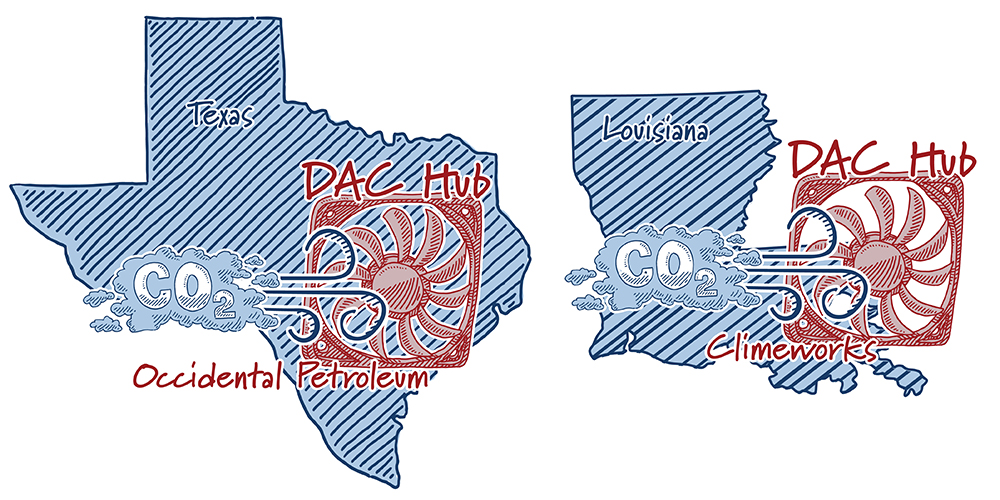Posted on March 28, 2024 by Savita Bowman
Even if we hit the brakes on emissions today, there is still too much carbon dioxide (CO2) in the atmosphere to meet net zero by 2050. Engineer and Professor Klaus Lackner realized this back in 1999, at the 24th Annual Technical Conference on Coal Utilization and Fuel Systems in Clearwater, FL, where he proposed the concept of directly scrubbing CO2 from the air. Fast forward to 2021, and a momentous milestone was achieved as the world’s first direct air capture (DAC) plant turned on in Iceland.
In 2021, Congress also provided the U.S. Department of Energy (DOE) a staggering $3.5 billion through the bipartisan Infrastructure Investment and Jobs Act (IIJA) to develop four Regional Direct Air Capture (DAC) Hubs, each with the capacity to capture 1 million metric tons of CO2 annually. While much of the federal investments in the IIJA were directed towards traditional projects such as roads and bridges, one significant section managed to revolutionize an industry: the Regional Direct Air Capture Hubs.
U.S. DAC innovators are eager to hit the ground running with their technology. In August 2023, DOE announced up to $1.2 billion for two DAC Hubs slated for award negotiations: the South Texas DAC Hub and Project Cypress in southwest Louisiana, both designed to capture a million metric tons of CO2. In March, Project Cypress, the first to emerge from negotiations, received the first portion of their award funding — $50 million issued by the DOE’s Office of Clean Energy Demonstrations (OCED). Battelle, the project lead, has indicated that an additional $51 million in private investment will be mobilized to kick-start the initial phase of the Project Cypress DAC Hub. DOE is anticipated to finalize the remaining $1.2 billion in DAC grants soon and is set to release an additional $2.4 billion in follow-on funding.
When included in a portfolio of innovative, clean technologies, DAC has the potential to provide a game-changing solution to the global challenge of removing excess carbon dioxide (CO2) already in our atmosphere. Research shows DAC can remove CO2 at the volumes needed to meet net-zero targets AND it can do so quickly.

Though the two million-ton DAC Hub winners are garnering the spotlight, there are 19 additional projects that will support earlier stages of DAC project development, including feasibility assessments and front-end engineering and design (FEED) studies. Of the 19, 14 projects will enable efforts to explore the feasibility of a potential DAC Hub location, ownership structure and business model. The remaining five projects will perform FEED studies establishing and defining technical requirements focused on project scope, schedule and costs to reduce risk during later phases.
While stakeholders eagerly await the finalization of these awards, DOE is already looking ahead to its next task of accelerating DAC deployment potential by supporting mid-scale commercial demonstration facilities. Last month, DOE issued a Request for Information on how to approach the development of DAC facilities with lower capture capacities of approximately 5,000–25,000 tons per year.
DOE’s Regional DAC Hubs represent a fusion of innovation and economic opportunity. Furthermore, these hubs offer a tangible solution to the pressing issue of climate change without resorting to heavy-handed regulations or mandates. By incentivizing private-sector investment in DAC technologies, the government empowers businesses to lead in reducing emissions while preserving economic competitiveness.
DAC Hubs showcase the potential for collaborative efforts between government and industry. The success of DAC technology hinges not only on its scalability but also on its capacity to integrate seamlessly into existing infrastructures and industries.
DAC is one of the many types of carbon dioxide removal (CDR) technologies that are taking on the challenge of removing CO2 from our atmosphere. Because of this, the program will lay the technical foundation for the future widespread commercialization of this critical suite of technologies. The yearly removal capacity for all U.S.-based CDR technologies is roughly one billion metric tons and 10 billion metric tons globally to reach net zero by 2050. With the DAC Hubs only clearing a percentage of the task, there is still a long road ahead. Other DOE initiatives like the CDR Pilot Prize are embracing a technology-inclusive approach to accelerate multiple CDR solutions, like enhanced weathering and bioenergy with carbon capture and storage, towards the billion metric ton goal. Bipartisan proposals, such as the Carbon Removal and Emissions Storage Technologies (CREST) Act of 2023 introduced by Senators Susan Collins (R-ME) and Maria Cantwell (D-WA), possess the ability to infuse the necessary resources toward this technology-inclusive DOE program.
The United States is leading the way for supportive policies for DAC innovation. As the DAC narrative unfolds, it underscores the importance of bold, forward-thinking American policies like the IIJA, which have the potential to catalyze transformative change within the industry.
